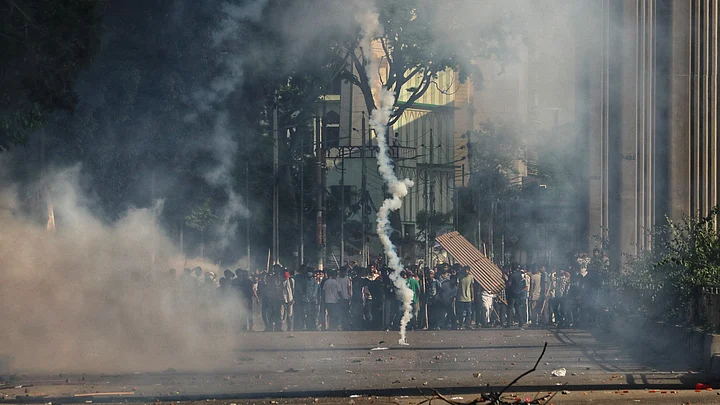Since Sunday evening, rumours of ousted Bangladeshi Prime Minister Sheikh Hasina’s resignation were already circulating. So when it came about in the afternoon, rapidly accompanied by a quick departure from her official residence, the only question was, where would she go?
Insiders said Agartala by chopper, followed by Delhi. Their predictions rang true. What followed was a bit of a surprise. The violent manner in which her residence was ransacked and the statue of her father, Bangabandhu Sheikh Mujibur Rehman, was pulled down, suggests a body blow to India’s foreign policy.
It's not that the Indian government did not know how rapidly the situation was spinning out of control after the students launched an agitation against the quota raj — a legacy of the 1971 liberation movement that gave reservations to the sons and daughters of the freedom fighters of the war fought against the Pakistani army that saw the death, rape, and disappearance of thousands.
But with Hasina out and unlikely to ever return to power, where does India stand now vis-à-vis Bangladesh?
The liberation war spawned many books and myths but also underlined the existential issues for the new country. Should it should be a secular country that preserves Bengali culture or an Islamic nation?
These fault lines have not been erased despite the last 15 years of Awami rule. Time and again they have re-surfaced regardless of who sat at the head of the table. Sheikh Hasina has been a tough politician. She understood the need to be firm, but she may have gone too far in her approach.
Many experts agree that India's strategy was distorted. In the name of controlling the Islamist threat, India supported a government that was averse to dissent and one that smothered democracy. That allowed cronies to prosper and engage in large-scale corruption.
Ever since Hasina came to power, the Indian establishment feared what is now unfolding in 2024. When Pranab Mukherjee was the president of India, there was an attempt to reach out to Hasina’s bete noire, the ailing Khalida Zia of the Bangladesh Nationalist Party (BNP). Even her son, Tariq, has been in touch with some Indian officials, but the government of India had no plans of how they could work with each other.
And as long as Hasina was in the saddle, the contacts with the BNP, seen to be close to Pakistan, have proved meaningless.
In the past, whenever the Indian High Commissioner sought to engage with opposition leaders, the Prime Minister’s office in Bangladesh would relay a message indicating that such interactions were not well-received by Hasina. As a result, these overtures were discontinued due to her sensitivities.
Indian foreign policy was a casualty, but Hasina rewarded India in her own way. New connectivity was created through the Maitri Setu bridge between Tripura and Bangladesh. Train connections like Bandhan and Mitali Express had come up. Similarly, there were innumerable flights between the two countries.
Trains stopped when the violence began earlier in July. It is possible that they may not start any time soon.
Border cooperation could be a casualty too. After all, Indian officials sing the praises of the Bangladeshi government for providing aid when it came to controlling insurgency in the Northeast. The Bangladeshi border force was very cooperative in handing over militants from Assam. The security agencies credit the neighbouring country for helping New Delhi. Some prominent ULFA leaders like Arun Chetia were handed over to Indian security forces.
But what happens now?
India would be keen that the basic structure of cooperation remains intact. Although options seem limited, the government in New Delhi may revive some of the links that it has created over the years to preserve this relationship. If that does not happen, then it will be a body blow to years of cooperation nurtured by both sides. Both trade and traffic between the two countries could take a cruel hit.
If the images coming from Dhaka in the last 24 hours are anything to go by, then the hostility towards India is palpable. Protestors are targeting everything that is linked to India, even the ambulances that were donated to the people of the country.
On social media, memes target the two Prime Ministers, with suggestions that Sheikh Hasina was pandering to the Hindu leader. It will be an uphill task to put the genie back in the bottle.
People close to the ousted prime minister blame the domestic policies of the BJP government like the Citizen’s Amendment Act (CAA) for India to be unpopular amongst the Bangladeshi populace. According to an Indian diplomat, PM Modi’s 2021 visit to Bangladesh during which he went about visiting Hindu temples rankled the local government. This did not go unnoticed and may visit Indian concerns more violently.
There are fears that if the army-led interim government does not get people off the roads of Bangladesh, then Hindus could be targeted in different parts of the country, which could lead to a new round of refugees crossing over to India. Will the troubled region of South Asia see the crises of 1947 and 1971 repeat themselves?
(The author is the editor of Delhi's Hardnews magazine. This is an opinion piece and the views expressed above are the author’s own. The Quint neither endorses nor is responsible for them.)
